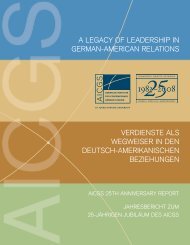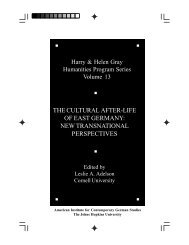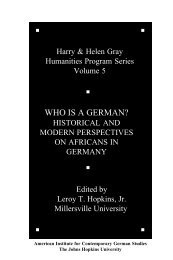the many sides of muslim integration: a german- american - aicgs
the many sides of muslim integration: a german- american - aicgs
the many sides of muslim integration: a german- american - aicgs
You also want an ePaper? Increase the reach of your titles
YUMPU automatically turns print PDFs into web optimized ePapers that Google loves.
<strong>the</strong> <strong>many</strong> <strong>sides</strong> <strong>of</strong> <strong>muslim</strong> <strong>integration</strong><br />
likely to acknowledge <strong>the</strong> importance <strong>of</strong> faith in <strong>the</strong>ir<br />
lives than o<strong>the</strong>r Americans (80 percent and 65<br />
percent, respectively), 20 <strong>the</strong>ir religious service attendance<br />
is similar to that <strong>of</strong> Protestants (41 percent)<br />
and Muslims are even less likely to pray daily<br />
compared to Christian believers (61 percent versus<br />
70 percent).<br />
Muslims in Ger<strong>many</strong> show a similar approach to religion<br />
compared to Muslims in <strong>the</strong> United States in<br />
terms <strong>of</strong> importance <strong>of</strong> religion (both above 80<br />
percent) as well as regarding fundamental religious<br />
duties (“<strong>the</strong> five pillars <strong>of</strong> Islam”), such as paying<br />
zakat 21 (more than 70 percent in <strong>the</strong> U.S. and<br />
Ger<strong>many</strong>) or fasting during Ramadan (more than 70<br />
percent in <strong>the</strong> U.S. and Ger<strong>many</strong>).<br />
However, <strong>the</strong>re are some differences concerning <strong>the</strong><br />
adherence to certain religious commandments.<br />
American Muslims seem to follow <strong>the</strong>se commandments<br />
more strictly, 22 such as <strong>the</strong> ban on alcohol (86<br />
percent in <strong>the</strong> U.S. versus 58 percent in Ger<strong>many</strong>),<br />
daily prayer (61 percent pray at least once a day in <strong>the</strong><br />
U.S. versus 39 percent in Ger<strong>many</strong>), wearing hijab 23<br />
(about 50 percent in <strong>the</strong> U.S. versus 30 percent in<br />
Ger<strong>many</strong>), and regularly visiting <strong>the</strong> mosque (41<br />
percent in <strong>the</strong> U.S. versus 34 percent in Ger<strong>many</strong>).<br />
Finally, <strong>the</strong> fundamental teachings <strong>of</strong> Islam are<br />
accepted by a large majority <strong>of</strong> Muslims in <strong>the</strong> United<br />
States. Nearly all (96 percent) believe in “One God”<br />
and <strong>the</strong> Day <strong>of</strong> Judgment (91 percent) whereas 78<br />
percent <strong>of</strong> German Muslim respondents do so. 24<br />
Hence, American Muslims display a higher level <strong>of</strong><br />
religious commitment in <strong>the</strong>ir everyday lives than<br />
Muslims in Ger<strong>many</strong>.<br />
SOME SIMILARITIES – MORE DIFFERENCES<br />
The comparative view on <strong>the</strong> composition <strong>of</strong> Muslim<br />
populations in both countries reveals some similarities<br />
but more differences. In both countries Muslims<br />
appear to be heterogeneous in terms <strong>of</strong> ethnic and<br />
regional background. But in Ger<strong>many</strong>, being Muslim<br />
is still associated with being Turkish due to <strong>the</strong> large<br />
number and <strong>the</strong> early arrival <strong>of</strong> this group. The high<br />
share <strong>of</strong> those who came as unskilled workers<br />
followed by <strong>the</strong>ir families has led to <strong>the</strong> widespread<br />
association <strong>of</strong> Muslims as a socially weak group <strong>of</strong><br />
20<br />
foreigners.<br />
Conversely, U.S. Muslims belong to various racial<br />
groups (except Hispanic) and can be found in<br />
different social classes. Thus, <strong>the</strong>y are not associated<br />
with a specific class, or with a single ethnic or<br />
racial group. A relatively high percentage <strong>of</strong> Muslim<br />
immigrants come to study in <strong>the</strong> United States or<br />
arrive with a high level <strong>of</strong> education and benefit from<br />
a solid educational background.<br />
Muslims in both countries are characterized by high<br />
religiosity, which is perceived differently in <strong>the</strong> U.S.<br />
and Ger<strong>many</strong>. Whereas in <strong>the</strong> U.S. Muslims’ religiosity<br />
is not perceived as uncommon or odd (despite an<br />
even higher degree <strong>of</strong> religious commitment than<br />
Ger<strong>many</strong>’s Muslims) due to <strong>the</strong> relatively high religiosity<br />
among a majority <strong>of</strong> Americans, in Ger<strong>many</strong><br />
<strong>the</strong> religiosity <strong>of</strong> Muslims is <strong>of</strong>ten regarded as out <strong>of</strong><br />
<strong>the</strong> ordinary. Thus, altoge<strong>the</strong>r, Muslims in Ger<strong>many</strong><br />
<strong>of</strong>ten are perceived as an alienated, socially marginalized<br />
group, while U.S. Muslims reflect <strong>the</strong> diverse<br />
nature <strong>of</strong> American society and do not particularly<br />
stand out.<br />
Socioeconomic Integration<br />
The following section focuses on <strong>the</strong> socioeconomic<br />
situation <strong>of</strong> Muslims in <strong>the</strong> U.S. and Ger<strong>many</strong> and is<br />
structured along four key indicators: Education,<br />
income, labor market <strong>integration</strong>, occupation, and<br />
social and language skills.<br />
EDUCATION<br />
Migration scholars agree that education provides<br />
immigrants with <strong>the</strong> major key to socioeconomic<br />
mobility. Thus, educational progress is equally<br />
accepted by German and American researchers as a<br />
variable for examining how immigrants integrate into<br />
a society. Moreover, <strong>the</strong> level <strong>of</strong> education achieved<br />
by foreign-born immigrants is an important indication<br />
<strong>of</strong> <strong>the</strong> socioeconomic resources and backgrounds a<br />
migrant group brings with it—resources that <strong>of</strong>ten<br />
determine <strong>the</strong> migrant group’s starting position in <strong>the</strong><br />
host country.<br />
Consequently, education <strong>of</strong> Muslim migrants in<br />
Ger<strong>many</strong> is one <strong>of</strong> <strong>the</strong> main aspects that scholars are





